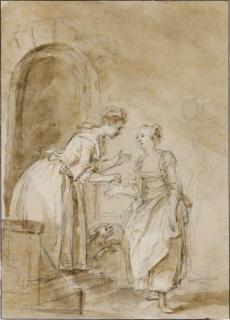


Jean-Honoré Fragonard was a fervid illustrator – yet not one of his series of drawings resulted in a complete set of illustrations to a book, not even the scenes from the Chevalier de Boufflers’ Aline, reine de Golconde (1761), of which this is one. As Marie-Anne Dupuy-Vachey suggested, it would appear that the artist made his several series of drawings, after La Fontaine, Tasso, Ariosto, Cervantes and others, essentially for his own pleasure. They were, in any case, often no more than sketches, and they seized the essentials of an episode, rather than making a painstakingly literal transposition of the author’s text. In this, he differed radically from the professional illustrators, known then as vignettistes – men such as Gravelot (1699-1773), Charles-Nicolas Cochin the Younger (1715-1790), Charles Eisen (1720-1778) or Jean-Michel Moreau (Moreau le Jeune; 1741-1814).
It is little short of a tragedy that he never did so, as he was the very kind of artist that the painter Antoine Renou (1731-1806) wished would illustrate books, instead of the petits maîtres into whose hands the tasks had fallen: ‘The root of the evil is that with us the dessinateurs are a breed on their own; let great artists make the drawings. If I had a book to embellish, it would not be your Mar[illiers], your Mon[nets] or your Coc[hins] that I would approach, but the leading painters and sculptors.’
Aline, reine de Golconde was a peculiarly appropriate little book for Fragonard to have illustrated: both author and artist were accused in their time of libertinage – less of themselves being libertines, than of writing, painting or drawing things that made light of sexual morality. The Chevalier Stanislas de Boufflers (1738-1815; whose mother, the Marquise de Boufflers, was a friend of Voltaire’s) was expelled from the seminary of Saint-Sulpice when his authorship of it came to light; not that this prevented his receiving, as abbé commendataire, the revenues of the abbeys conferred on him by King Stanislaus Leszczynski, Duke of Lorraine, whose mistress was his mother. Later editions of the book toned down its content. Fragonard’s illustrations, however, seem to be of the text of the original edition; in which case, they were probably made very soon after his return to Paris in September 1761, after travelling in Italy with another abbé commendataire, Jean-Claude Richard de Saint-Non.
He trained in Paris with Jean-Baptiste-Siméon Chardin and then François Boucher, winning the Prix de Rome in 1752. He excelled as a painter, draughtsman and printmaker. Though his reputation rests indubitably on his Rococo scenes of intimacy and joie de vivre, in which he captured the essence of an era, his talent and fluid manner can also be seen in his skilful portraits and landscapes. During the Revolution, he assisted in organising the opening of the Louvre as a public museum.